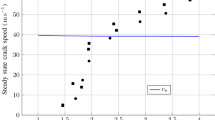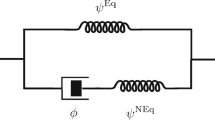Abstract
Fracture models addressing crack propagation in viscoelastic materials typically draw on cohesive force distributions coupled with a linearly viscoelastic constitutive material description. While the resulting formulation of the crack speed as a function of applied loads provides good agreement with measurements on polyurethane rubber as well as three other rubbery solids studied by A. N. Gent on the more global scale, the size of the cohesive zone required to match theory and measurements is unreasonably small. Although this glaring discrepancy has not deterred the use of the theory for viscoelastic fracture, it has remained a troublesome question on the wider applications to polymer fracture. The present note revisits this issue and draws on results developed during the past decade to explain this discrepancy via the effect of stress-induced dilatation on the relaxation or retardation times of viscoelastic solids.
Similar content being viewed by others
References
Barenblatt GI (1959) The formation of equilibrium cracks during brittle fracture. General ideas and hypothesis. Axisymmetrical cracks. PMM 23: 434–444
Barenblatt GI (1962) Mathematical theory of equilibrium cracks. In: (eds) Adv Appl Mech. Academic Press, New York, pp 55–125
Chakkarapani V, Ravi-Chandar K, Liechti KM (2006) Characterization of multiaxial constitutive properties of rubbery polymers. J Eng Mater Technol 128: 489–494
Dugdale DS (1960) Yielding of steel sheets containing slits. J Mech Phys Solids 8: 100–104
Ferry JD (1961) Physical properties of polymers. Wiley, NY
Fillers RW, Tschoegl NW (1977) The effect of pressure on the mechanical properties of polymers. Trans Soc Rheol 21: 51–100
Gent AN, Lai S-M, Nah C, Wang C (1994) Viscoelastic effects in cutting and tearing rubber. Rubber Chem Technol 67: 610–618
Gent AN, Lai S-M (1994) Interfacial bonding, energy dissipation and adhesion. J Polym Sci Phys 32: 1543–1555
Gent AN (1996) Adhesion and strength of viscoelastic solids, is there a relationship between adhesion and bulk properties?. Langmuir 12: 4492–4496
Hsiao CC, Sauer JA (1950) On crazing of linear high polymers. J Appl Phys 21: 1071–1083
Kaelble DH (1960) Theory and analysis of peel adhesion: bond stresses and distributions. Trans Soc Rheol 4: 45–73
Kaelble DH (1965) Peel adhesion: micro-fracture mechanics of interfacial unbonding of polymers. Trans Soc Rheol 9(2): 125–163
Knauss WG (1970) Delayed failure—-the Griffith problem for linearly viscoelastic materials; 1970. Int J Fract 6(1): 7–20
Knauss WG (1974) On the steady propagation of a crack in a viscoelastic sheet: experiments and analysis. In: Kausch HH, Hassell JA, Jaffee RI (eds) Deformation and fracture of high polymers. Plenum Press, NY-London, pp 501–541
Knauss WG, Emri IJ (1981) Non-linear viscoelasticity based on free volume consideration. Comput Struct 13: 123–128
Knauss WG, Losi GU (1993) Crack propagation in a nonlinearly viscoelastic solid with relevance to adhesive bond failure. JAM 60: 793–801
Knauss WG (1993) Time dependent fracture and cohesive zones. J Eng Mater Technol 115: 262–267
Knauss WG (2003) Viscoelasticity and the time-dependent fracture of polymers comprehensive structural integrity, vol 2, fundamental theories and mechanisms of failure. Elsevier, Amsterdam, pp 383–428
Knauss WG (2011) On the importance of the dilatational component of the stress state in the uniaxial yield-like behavior of rate-dependent polymers: C. Bauwens-Crowet Revisited. Mech Time-Dep Mater (accepted)
Knauss WG, Müller HK (1975) Discussion of “On the governing equation for quasi-static crack propagation in linearly viscoelastic materials” by R.J. Nuismer. JAM 42: 520–521
Kovalchik C (2011) Mechanics of peeling: cohesive zone law and stability. Ph.D. Thesis, California Institute of Technology, June 2011
Lauterwasser BD, Kramer EJ (1979) Microscopic mechanisms and mechanics of craze growth and fracture. Phil Mag A39: 469–495
Müller HK, Knauss WG (1971) Crack propagation in a linearly viscoelastic strip. JAM 38(Series E): 483–488
Moonan WK, Tschoegl NW (1985) The effect of pressure on the mechanical properties of polymers IV. Measurements in torsion. J Polym Sci Polym Phys Ed 23: 623–651
Nuismer RJ (1974) On the governing equation for quasi-static crack propagation in linearly viscoelastic materials. JAM 41: 631–634
Parvin M, Knauss WG (1987) An experimental arrangement to estimate the failure behavior of an uncrosslinked polymer under high spatial constraint. Polym Sci Technol 37: 111–128
Parvin M, Knauss WG (1990) Damage induced constitutive response of a thermoplastic related to composites and adhesive bonding. Int J Fract 42: 57–72
Popelar CF, Liechti KM (1997) Multiaxial nonlinear viscoelastic characterization and modeling of a structural adhesive. J Eng Mater Technol Trans ASME 119: 205–210
Popelar CF, Liechti KM (2003) A distortion-modified free volume theory for nonlinear viscoelastic behavior. Mech Time-Depend Mater 7: 89–141
Prandtl L (1933) Ein Gedankenmodell für den Zereiβvorgang Spröder Körper (a thought model for the fracture process of brittle solids), Zeitschr. angew. Math. Mech., 13, pp 129–133 Translation available via: http://resolver.caltech.edu/CaltechAUTHORS:20110622-132946088
Qvale D, Ravi-Chandar K (2004) Viscoelastic characterization of polymers under multiaxial compression. Mech Time-Depend Mater 8: 193–214
Ravi-Chandar K, Ma Z (2000) Inelastic deformation in polymers under multiaxial compression. Mech Time-Depend Mater 4: 333–357
Schapery RA (1975) A theory of crack initiation and growth in viscoelastic media. I. Theoretical development. Int J Fract 11(1): 141–159
Schapery RA (1975) A theory of crack initiation and growth in viscoelastic media. II. Approximate methods of analysis. Int J Fract 11(3): 369–388
Schapery RA (1975) A theory of crack initiation and growth in viscoelastic media. III analysis of continuous growth. Int J Fract 11(3): 369–388
Ungsuwarungsri T, Knauss WG (1987) The role of damage-softened material behavior in the fracture of composites and adhesives. Int J Fract 35: 221–241
Ungsuwarungsri T, Knauss WG (1988a) A nonlinear analysis of an equilibrium craze: part I—problem formulation and solution. JAM 110, Trans ASME 55: 44–51
Ungsuwarungsri T, Knauss WG (1988b) A nonlinear analysis of an equilibrium craze: part II—simulations of craze and crack growth. JAM 110, Trans ASME 55: 52–58
Williams ML, Landel RF, Ferry JD (1955) The temperature dependence of relaxation mechanisms in amorphous polymers and other glassforming liquids. J Am Chem Soc 77: 3701–3707
Author information
Authors and Affiliations
Corresponding author
Rights and permissions
About this article
Cite this article
Knauss, W.G. A note on the role of dilatation in the fracture of viscoelastic elastomer. Int J Fract 171, 99–104 (2011). https://doi.org/10.1007/s10704-011-9629-3
Received:
Accepted:
Published:
Issue Date:
DOI: https://doi.org/10.1007/s10704-011-9629-3




